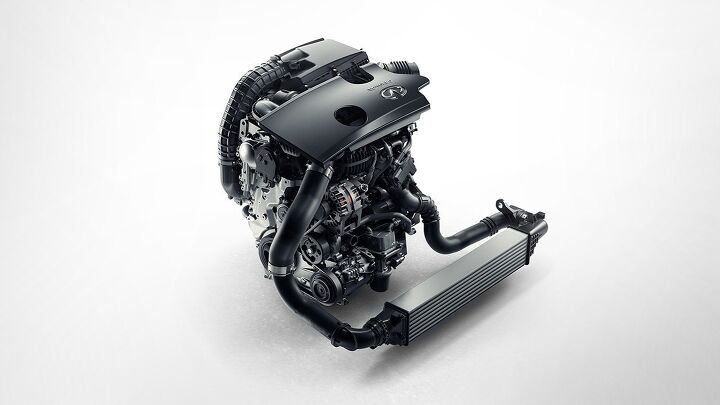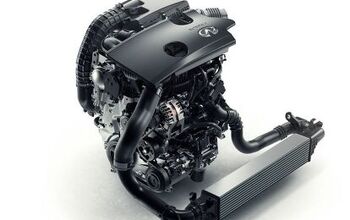Compression Test: Infiniti Set to Unveil a Variable Compression Engine

We’ve mused on Infiniti’s Variable Compression Engine in the past, calling it everything from a chameleon to the holy grail. Its killer app? The ability to changes the distance the pistons travel in their cylinders by as much as 6 mm, or about a quarter of an inch.
Why is this important? Because it is, arguably, the first major change to the workings of a internal combustion engine in more than a century.
Certainly, advancements in the areas of ignition and fuel injection have allowed manufacturers to make huge leaps forward in the never-ending quest for more power and greater efficiency. At its core, though, all those innovations have been addendums to the internal combustion engine — improving its supporting cast without upgrading the main star.
“VC-Turbo technology is a step change for Infiniti,” explains Roland Krueger, chairman and global president of Infiniti and senior veep of Nissan. “It is a revolutionary next-step in optimizing the efficiency of the internal combustion engine. This breakthrough delivers the power of a high-performance 2.0-liter turbo gasoline engine with a high level of efficiency at the same time.”
Sounds a lot like the promises made when manufacturers starting downsizing the displacements of their engine fleet and slapping on turbochargers. The difference here, though, is that the VC-T engine fundamentally changes how an engine works.
As most readers know, pistons in conventional internal combustion engines travel the same distance up and down in the cylinder, regardless of speed and vehicle load. The times this doesn’t happen can be counted on one hand, such as when cylinder-deactivation technology kicks in or the timing belt lets go on a ratty ’92 Escort at highway speed, causing all the valves to depart the 1.9-liter engine and dance on the hood. This is a purely hypothetical example, of course, and not something that happened to this author while trying to court a new girlfriend 20 years ago. She started dating someone with a Fox-body Mustang instead.
Anyway. The pistons are connected to rods, which are mounted to a crankshaft. The engine’s compression ratio is fixed, determined by the amount of space above the pistons when they are at top-dead center. The smaller the space above the pistons, the higher the compression ratio and, generally, the greater an engine’s power output.
Here’s where the VC-T engine departs from its mundane brethren. The pistons in the VC-T are connected to rods which are in turn attached to one end of an elliptic device Nissan calls a multilink. This multilink is mounted on the crankshaft where the connecting rods would normally be found.
The opposite end of the multilink has a short rod connected to a shaft. An electric actuator moves the shaft, causing the multilink to tilt up or down slightly. When the end of the multilink closest to the piston is tilted up, the piston travels to the top of the cylinder, providing a compression of 14:1. When the multilink tilts down, the piston’s travel in the cylinder is stopped before it reaches top-dead center. This lowers the compression ratio to 8:1.
Here’s the kicker — because the turbocharger kicks in at this time to fill in the blanks, the engine’s power output increases. The turbo pressurizes each cylinder with a dense mix of fuel and air. This increases power.
According to Infiniti, these two compression extremes are simply that — the extremes. The system apparently has the ability to vary compression between the two bookends of 8:1 (for high performance) and 14:1 (for high efficiency). The engine control logic automatically applies the optimum ratio, depending on what the driving situation demands.
This also means the displacement of the engine changes as the multilink does its job. Will Nissan advertise the engine as a 1.6-2.0-2.4-liter? Those questions remain, as yet, unanswered.
Nissan’s chief powertrain engineer, Shinichi Kiga, has stated Infiniti’s VC-T engine is expected to deliver a EPA fuel economy gain of 27 percent over the QX50s’s outgoing 3.7-liter V-6 on the combined city-highway cycle. The engine is rated at 268 horsepower and 288 pound-feet of torque, says Kiga, who expects the 2019 QX50 will reach 60 mph almost one second faster than its four-cylinder competitors.
Now, we have seen this story play out before — a breathless announcement from an automaker saying its new engine technology is going to revolutionize the modern automobile. Witness the rotary engine from Mazda, the Miller cycle patented back in 1957, and various iterations of gasoline engines that don’t need spark plugs.
It would be unfair to write off those technologies as flashes in the pan, as most of them failed to become popular thanks to deficiencies of marketing and consumer perception, not engineering. However, the VC-T from Infiniti stands an excellent chance of hitting the big time, mostly because it solves problems that have been vexing engine builders for decades.
We’ll likely see this new technology in the 2019 Infiniti QX50 at the upcoming L.A. Auto Show.
[Images: Infiniti]

Matthew buys, sells, fixes, & races cars. As a human index of auto & auction knowledge, he is fond of making money and offering loud opinions.
More by Matthew Guy
Latest Car Reviews
Read moreLatest Product Reviews
Read moreRecent Comments
- Bd2 The "e" nomenclature signifies the e-ATPs which BMW is pursuing.
- Dave M. I'm sorry to see any storied name go away. The lifespan of the Malibu has fit perfectly in my lifetime years-wise. Some of the highlights include the first and second generations, the '78 revamp (very clean design), and the 2005 generation. Ford, GM and Mopar gave this segment away by allowing Toyota and Honda a foot in the door and then always having to play catch-up. How hard is it to make a truly competitive sedan at a profit? Obviously, Japan Inc. figured it out.I've driven a few rentals these past years; the Malibu got the job done but honestly the Passat and Altima were my rental preferences.
- Kcflyer actually yes. It's a shame that a product this uncompetitive can still outsell GM's entire EV offerings. Those products have had billions thrown at them. Imagine how nice the new Malibu, Impala, SS, and Lacrosse would be with that kind of commitment.
- 3SpeedAutomatic Nope....
- Bd2 Looking forward to flooding the rental lots with Hyundai and Kia models, this is just one obstacle now eliminated.



































Comments
Join the conversation
I am not exactly an engineer but I am curious: could this effect also be achieved by sliding tops for the combustion chambers?
@ golden2huskey "Presently the US generates 10% of its electrical energy from solar and wind. Not a bad start." As of 2016 just under 15% of US electricity was produced by all renewable energy. Of that wind was 20.8%, solar 15.8%. https://en.m.wikipedia.org/wiki/Renewable_energy_in_the_United_States By my math that put solar and wind at 4% not 10% as you claim.